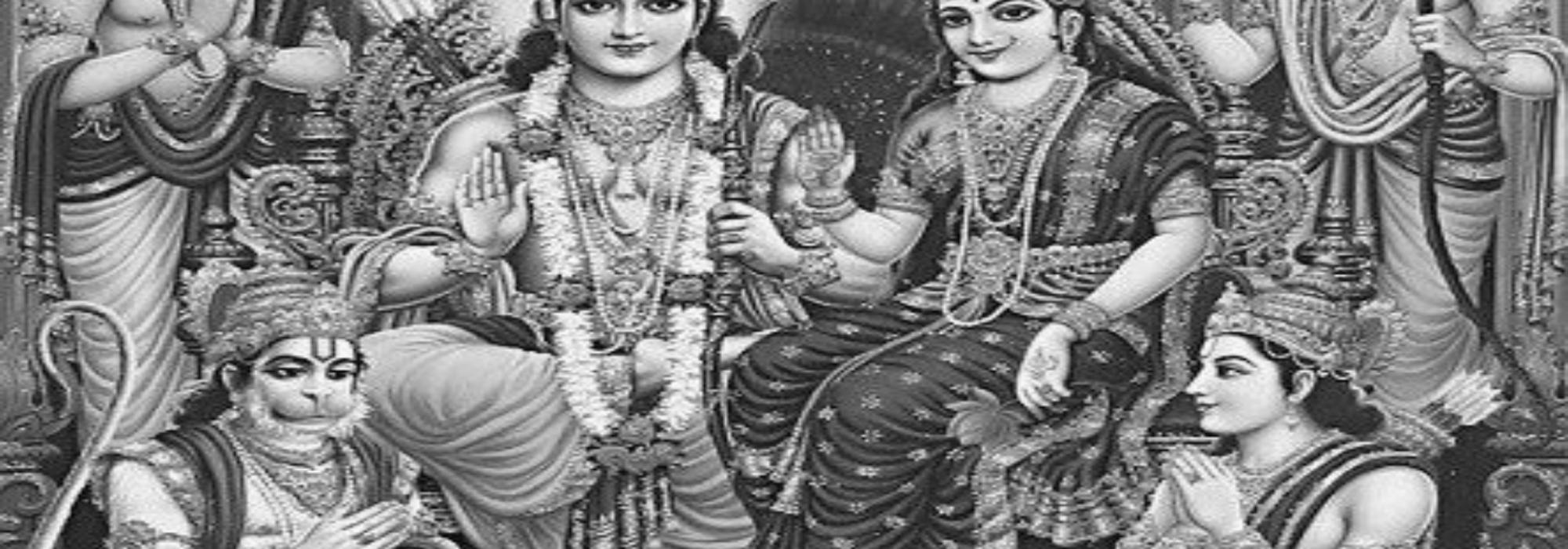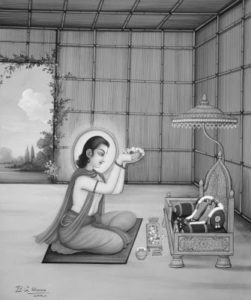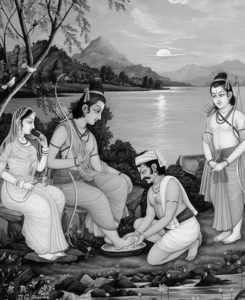When Dasharatha orders Rama’s banishment, he again rushes to his mother to give her solace. At that moment, Kausalya reminds Rama that the mother is a hundred times more important than the father, and that it is more important to heed to the words of the mother than the father. Saying so, she orders him to take her along with him into the forests. But if that happens, the family would break; husband and wife would separate. Rama doesn’t want his parents to separate. His response is at once dharmic and clever. He tells his mother, “You are first the wife of my father and only then you are my mother. Your duty is to be with your husband, not with your son. You are verily one half of the household while Father is the other half. You should support your husband’s word. You can’t come to the forest with me!” (See Ayodhyakāṇḍa, sargas 21-25) Later Sita uses these very words to convince Rama that she will join him!
Rama decides that he will go alone to the forest as per Kaikeyi’s wishes. He tells Sita, “I came to meet you before setting out into the lonely forest. Never praise me in front of Bharata. Those in power will hardly tolerate the praise of others. So don’t mention my virtues in front of him.”
सोऽहं त्वामागतः द्रष्टुं
प्रस्थितो विजनं वनम् ।
भरतस्य समीपे ते
नाहं कथ्यः कदाचन ॥
ऋद्धि युक्ता हि पुरुषा
न सहन्ते परस्तवम् ।
तस्मान्न ते गुणाः कथ्या
भरतस्याग्रतो मम ॥
(Ayodhyakāṇḍa 26.24-25)
But Sita joins him and so does Lakshmana. Rama is thus never alone. Though he now has company with him, he ensures that back home the rest of the family lives in harmony – Bharata, Shatrughna, and Sumitra, along with the rest.
The extent of Rama’s family-focus can be seen later in the epic. After killing Ravana, Rama rides on the
puṣpakavimāna to get back home. Bharata, who is at Nandigrama, had taken an oath that if Rama were to delay in returning—after fourteen years—even by a day, he would jump into fire. Perhaps Rama resorts to the aerial route primarily to avoid Bharata fulfilling his rigid oath. On the way back, Rama and his entourage stop briefly at Bharadvaja’s hermitage. Rama tells Hanuman to fly to Nandigrama and give the news to Bharata. Then he says, “If there is even a slight hint of dismay on Bharata’s face, rush back and let me know.” Indeed Bharata had promised to return the kingdom to Rama after fourteen years and had refused even to sit on the throne; instead he had placed Rama’s sandals as a symbol. But after being in power for fourteen years, who knows how the mind would have changed. If Bharata was happy with ruling the kingdom and was now troubled by the news of Rama’s arrival, then Rama need not return; he could go away elsewhere without worrying. Such was his love for the family; his sacrifice would be nothing compared to the relationship that would be retained – such was his thinking. Bharata, of course, was redoubtable in his integrity. Hanuman doesn’t return from his journey to Nandigrama and Rama guesses what must have transpired between the two.
Rama’s family-consciousness was such that he was interested not just in keeping his family happy but cared deeply for the families of others too. When the battle between Vali and Sugriva couldn’t be resolved by peaceful means and Vali had to be killed, he tries to avoid further conflict. When Tara lambasts him, he doesn’t say harsh words in response but consoles her. He orders Sugriva to make Angada the crown-prince. Then Tara marries Sugriva, thus strengthening that family. And when Sugriva performs the last rites of his elder brother, Rama too joins him with the same emotional fervour. When Vibhishana comes to Rama unable to bear with the atrocities committed by his brother, Rama accepts him merely with the aim of providing succour to a person in need and not with evil designs of creating a divide in the kingdom of Lanka. And after Ravana’s death when Vibhishana says in disgust that he will not perform the last rites of such a monster, Rama tells him, “There is no enmity after death. If you will not undertake the final rituals, then treating Ravana as my own elder brother, I will do it!”
मरणान्तानि वैराणि
निर्वृत्तं नः प्रयोजनम् ।
क्रियतामस्य संस्कारो
ममाप्येष यथा तव ॥
(Yuddhakāṇḍa 112.26)
Such is the magnanimity and the family-orientation of Rama! While the death is irreversible, the lives of those who are alive should not be bitter. This was the vision of Rama. In the Sītā-parityāga episode, with the view that the families of his subjects should not develop suspicion about one another, he was willing to give a death-blow to his own family life. For the sake of the larger familial welfare, he was willing to sacrifice his own beloved.
Rama was a person who was willing to make anyone as part of his family. We see this first in the case of Guha, the boatman. Rama tells him, “Until now we were four brothers. Now we are five!” He then tells Sugriva, “Until now we were five brothers, now we are six.” And then he tells Vibhishana, “Until now we were six brothers, now we are seven.” And it wasn’t just empty words to impress the other person but something that sprung from a sense of genuine camaraderie. If not, all these people – be it Guha or Vibhishana, Sugriva or Hanuman – wouldn’t have been with Rama during times of adversity, and with such affection. It is interesting to see that all these people are from different backgrounds. While Rama was from a royal family, Guha was a niṣāda king from a family of hunters. Sugriva and Hanuman were monkey-kings. Vibhishana was a demon-king. It is unusual for someone from a royal family to befriend people who are below their so-called dignity. But Rama has no such qualms; for him, all of them are family – he has such an inclusive mindset. In fact, after the war is fought and when Vibhishana brings Sita—all decked up—in a palanquin, the hordes of monkeys and demons wish to take a look at her. Vibhishana tries to push them away (much like the zed security of today) and Rama gets upset at this. He says, “Why do you harass these people disregarding me? Stop, stop this force. After all, they are my people!”
किमर्थं मामनादृत्य
कृश्यतेऽयं त्वया जनः ।
निवर्तयैनमुद्योगं
जनोऽयं स्वजनो मम ॥
(Yuddhakāṇḍa 117.25)
Rama had great regard for his family and clan. He adhered to the kṣātra-dharma as part of his identity. He respected what his family was renowned for. He learnt the knowledge that his family had held dear. He considered it a great honour to be doing the works that were part of his birth and upbringing. Once, during their time in exile, Sita asks Rama why he should kill the demons at the behest of the sages, especially given that they had not directly caused harm to either of them (the famous verse ‘snehācca bahumānācca smāraye tvāṃ na śikṣaye | na kathañcana sā kāryā gṛhīta dhanuṣā tvayā’ comes here; in sarga 9 of the Araṇyakāṇḍa). Rama replies, “What you say is true – the demons have not harmed us. Further, we are living in the forest as ascetics so it is not right to take up arms. However, first I am a kṣatriya. It is my duty, from my birth, to protect and to help.” (See Araṇyakāṇḍa, sarga 10)
Rama also knew that as a kṣatriya, he had to give others, not receive from them. When Guha offers his hospitality,
Rama gently refuses and instead asks for his horses to be fed. Rama on his part goes to bed after drinking some water. In the Araṇyakāṇḍa (5.33), when the seer Sharabhanga offers Rama all his puṇya, Rama gently refuses and tells the seer that he will attain the highest heavens of his own deeds and actions.
Rama was also particular about seeing the logical conclusion of an oath. If he had to go to the forest for fourteen years, it would be so. He could have easily chosen to stay incognito in another city. After entering the forest from Ayodhya, he could have easily gone off to Videha and spent fourteen years in his father-in-law’s house. Janaka would have been happy as would have been Sita. But he did not do that. He stuck to his path, his chosen journey. There is no chance for a compromise in such matters. Even when Sugriva invites him to live in Kishkinda, Rama refuses and instead stays in a cave in the jungle. When Sugriva was crowned king, Rama did not go; he sent Lakshmana. It was the same with Vibhishana. Rama did not enter Lanka; it was Lakshmana again. After all, nothing was imposed on Lakshmana. He chose to accompany Rama, and so technically he was free to do what he wanted. Thus, even when nobody was watching, Rama walked the path of integrity, for he knew no other.
An important aspect of family life is the love between husband and wife. The love between Rama and Sita was unmatched. They are a great role model for couples everywhere. Indeed, we see this love between Shiva and Parvati as well. In fact, both of them went through a great deal of penance to obtain one another. And having united, in the form of ardhanārīśvara, they become parts of the same whole. They become one and indivisible. Thus they are the ideal couple. But in the case of Sita and Rama, we find role models for family life because theirs was realistic, not idealistic. We see in the Rāmāyaṇa so many ups and downs, emotional upheavals and disagreements. But Rama’s nature was to go beyond them. This is why we find Sita telling Anasuya about her svayaṃvara and what an ideal husband she has. Speaking about Rama, she tells Anasuya, “He has conquered his senses, he has compassion, he treads the path of dharma, he deeply loves me, and is a man of virtue; indeed he looks after me as well as my parents!”
किं पुनर्यो गुणश्लाघ्यः
सानुक्रोशो जितेन्द्रियः ।
स्थिरानुरागो धर्मात्मा
मातृवर्ती पितृप्रियः ॥
(Ayodhyakāṇḍa 118.4)
He was a fatherly and motherly figure to Sita – what a great thing this is!
In the Ayodhyakāṇḍa, we also find references to Rama cooking. He affectionately prepares a feast for Sita by barbecuing the fresh meat that he had hunted. He feeds it to her with great love. (See Ayodhyakāṇḍa 96.1-2. In the previous two sargas, Valmiki composes a beautiful description of Chitrakuta and then Ganga.) The poet tells us that when Rama saw Sita looking longingly at a flower, he would immediately bring it for her. Of course, in the dense forest, there would hardly be a soul to enjoy the sight of her ornamentation, but Rama didn’t bother about that. He tried to please Sita in every way, and often even without her asking for it openly!
In Kannada, there’s a famous proverb that roughly translates into “using a divine weapon against a mere sparrow.” Rama pretty much did the same thing when he used the brahmāstra against the demon Kakasura, who was in the shape of a crow. Such was his love for Sita that he readily used his strongest weapon against a demon that was harassing her.
To be continued.
This serialized article has been translated by Hari Ravikumar from the author’s Kannada lecture held at the Gokhale Institute of Public Affairs, Bangalore in 2009. All verse references from the Rāmāyaṇa are from Vidvan Ranganatha Sharma’s Kannada translation of the epic in eight volumes (published by the Ramayana Prakashana Samiti, Bangalore).
[contact-form][contact-field label="Name" type="name" required="true" /][contact-field label="Email" type="email" required="true" /][contact-field label="Website" type="url" /][contact-field label="Message" type="textarea" /][/contact-form]













































Comments